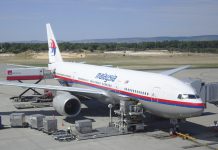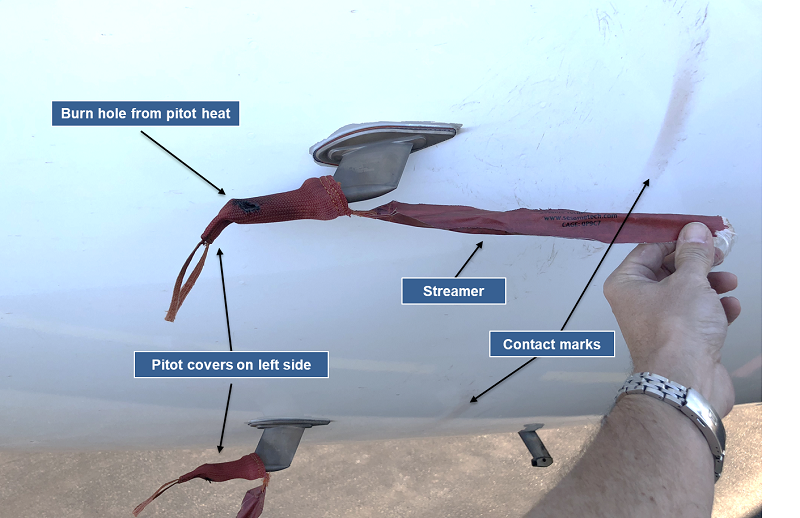Australian air crash investigators have issued a safety warning about pre-flight inspections of pitot tubes after a Malaysia Airlines jet took off with covers still on the crucial airspeed devices despite multiple opportunities to detect them.
The Australian Transport Safety Bureau Thursday called on airlines operating to Brisbane to ensure they had rigorous processes in place to ensure pitot tube covers are removed prior to flight.
The warning came as a preliminary report confirmed the covers remained on the Malaysian aircraft throughout its flight from Brisbane Airport on July 18 despite separate inspections by the captain and a Malaysia Airlines engineer.
The Airbus A330, 9M-MTK, heading to Kuala Lumpur declared a PAN alert and returned to the airport after the pilots reported the airspeed indicators had failed.
Pitot tubes measure static and kinetic air pressure in a moving aircraft to determine the indicated airspeed. They provide critical information to the air data computers and flight instruments.
They are considered critical to an aircraft’s safety and there have been several incidents and accidents related to pitot tube failures, including the crash of Air France Flight 447, also an A330, in the Atlantic Ocean in 2009.
“This is a serious incident,’’ ATSB chief commissioner Greg Hood said. “The CCTV footage shows that the three covers were in place on the aircraft as it pushed back from the terminal and as it accelerated down the runway.
“Now this limited the amount of critical information that’s available to flight crew during the take-off and in fact during the short flight, up to 10,000ft, and then the return to Brisbane Airport, where the aircraft landed safely.”
The covers, which have red streamers attached to them, were placed on the aircraft’s three pitot probes soon after the aircraft landed. The covers are needed in Brisbane to guard against wasps which build nests in the tubes.
However, the covers were not identified during inspections of the plane and they were not moved prior to take-off.

Investigators said both Malaysia Airlines personnel and ground handling workers were responsible for conducting pre-departure checks.
On the day of the incident, aircraft turnaround duties were shared between a Malaysian maintenance engineer, two non-certifying engineers from an engineering support provider and four ground handlers.
“The presence of the pitot covers was not detected by the operator’s maintenance engineer or captain during separate external aircraft inspections,” the report said.
“The operator’s maintenance engineer boarded the aircraft during turnaround, and the engineering support personnel left the bay to attend to other aircraft. The pitot covers were not detected by ground handlers during pushback.”
READ: MH370 unlikely to be north or south of existing search area, says scientist.
The first officer was flying the plane and the captain was monitoring. Under Malaysia Airline’s standard operating procedures, the pilot monitoring was required to announce when the airspeed reached 100 knots and the pilot flying needed to cross-check this airspeed indication.
A transcript from the cockpit voice recorder shows the captain called 100 knots as the groundspeed reached 100 knots and the first officer initiated rotation when the groundspeed was 165 knots. The maximum decision speed at which a rejected take-off could be initiated during an emergency, known as V1, had been calculated at 153 knots.
“The flight crew recalled that they detected an airspeed anomaly during the take-off roll, including red speed (SPD) flags on both primary flight displays (PFD),’’ the report said.
“The standard operating procedures stated that the captain held responsibility for the decision to reject the take-off or continue.
“ It stated that rejecting a take-off between 100 kt and V1 was a serious matter, that a captain should be ‘go-minded’, and that very few situations should lead to the decision to reject the take-off.
“There was no indication on the CVR recording that the captain or the first officer discussed rejecting the take-off.”
After take-off, the crew carried out procedures for unreliable airspeed indications and made a PAN call, an international call that indicates an urgent safety problem but is below an emergency, to air traffic control.
The crew continued to climb above 10,000ft and took the aircraft to the north-east of Brisbane Airport where they carried out checklists and troubleshooting ahead of landing.
This included turning off three air data reference systems and gaining access to a color-coded speed scale derived from angle of attack and other information and altitude derived from GPS data.
They also obtained groundspeed information from air traffic control.

“Normal landing gear extension could not be accomplished with all three ADRs off,’’ the report said.
“The flight crew performed a landing gear gravity extension before conducting an overweight] landing on runway 01 at 0033.
“After landing the flight crew stopped the aircraft on the runway as nose wheel steering was unavailable following a landing gear gravity extension. The main landing gear doors, which remain open following a gravity extension, had minor damage where they contacted the runway surface.”
The aircraft was towed to the gate where passengers and crew disembarked without any reported injuries and a subsequent inspection revealed the pitot covers were still on the plane.
Hood said the continuing investigation would focus specifically on the role of flight and ground crew in pre-flight checks as well as the cockpit warnings received by the pilots as they accelerated down Brisbane’s runway 01.
“Today we’re issuing a safety advisory notice to all operators to take particular care and review their procedures for the fitment of pitot covers on landing at Brisbane Airport and ensure that their processes are robust for the removal of these covers prior to flight,’’ he said.
























